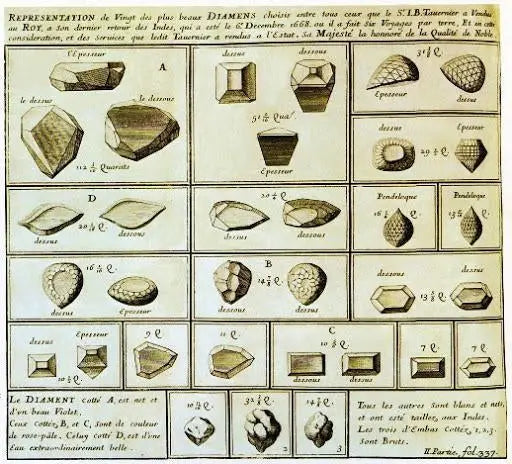
Antique Cut Diamonds: French Cut
The French cut, a simple cut with a pretty play of light, is an antique diamond cut that evolved from the table cut and is considered the first faceted diamond cut.
The table cut, believed to have originated in the 15th century, is made by removing one of the points of a natural octahedral diamond crystal to create a flat, four-sided top facet or “table.” The opposite point is also flattened. This results in a diamond with a flat, square-ish facet on top and a flat culet on the bottom, while the remaining eight crystal faces form four beveled facets on the crown and four on the pavilion.
The French cut also dates back to the 15th century but was popularized in the 17th century among European royalty and nobility before the brilliant cut became more common. The French cut introduced a triangular facet that extends from each corner of the table down to the girdle, adding more facets to the crown.
When viewed from above, this cut creates a square crown with nine facets. The table sits high on the crown, with its four corners positioned between the crown’s corner facets, forming the appearance of a diagonal cross or four-pointed star. The additional corner facets further enhance light reflection.
Some French cuts further divide the triangular corner facets, giving the table an octagonal shape for even more intricate light reflection. There was also a variation with a flat bottom, similar to cuts without a pavilion, such as the rose cut, but still featuring the distinctive French-cut crown.
The name “French cut” likely came from its greater popularity in France at the time. It experienced a resurgence during the Art Deco period in the early 20th century when its geometric style perfectly complemented the bold, exotic designs and fine craftsmanship that characterized the era’s jewelry and watches.
The main appeal of the French cut lies in its simple elegance and subtle sparkle, which makes it ideal for small accent stones that enhance the main gemstone. French-cut diamonds are also especially striking in dangling jewels, where their visual effects can be appreciated from all angles, or when placed together.
Today, original French-cut diamonds are rare, having been largely replaced by modern shapes and cutting styles. However, the French cut remains in demand due to its versatility, adding unique visual beauty to a wide range of jewelry designs.
Photo: Pin from the Jogani collection featuring French-cut diamonds.

